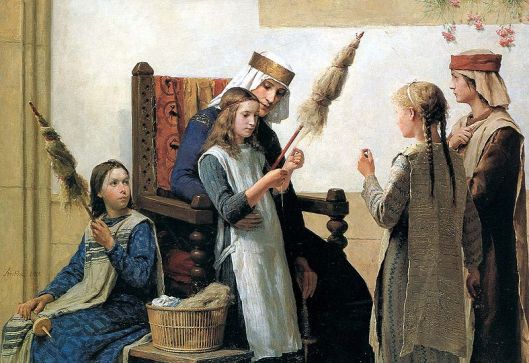I was recently in England, hiking and biking in Dartmoor National Park, and I spent a good deal of time woolgathering. This was not the kind of woolgathering you may be imagining, if you think of “woolgathering” as “daydreaming”. Not as common as it once was, you will still see this expression from time to time. You may be quite familiar with it if you are a fan of 19th century literature, as I am. In any case, picture a school child staring out of the window, thoughts floating on the clouds. She would be said to be “gathering wool”. Brewer’s Dictionary of Phrase and Fable defined “gathering wool” as “to be absentminded, but to be so with no good purpose.”
My adventures on Dartmoor were of a much different kind. As I was riding along on my bike, I would notice a great clump of wool on a fence or bush. I would turn my bike around, dismount, bound into the bushes by the roadside, and gather as much wool as my hands could hold. I would stuff this into my pockets and repeat the activity when I saw more wool by the side of the road. My companions were terribly amused by this performance and wondered at the usefulness of my endeavors. But I do intend to use the fleece to go good effect. But it did make me wonder at the traditional use of the term woolgathering.
So I was gratified when I ran across an article by Oxford etymologist, Anatoly Liberman, whose interpretation of the idiom was much more in line with what I was actually doing. According to Liberman, the origins of the term are a bit fuzzy (you might say wooly?). He did find references to the occupation of actual woolgathering to be anything but idle, but indeed quite productive. In a 19th century magazine, one contributor told of farmers that he knew who used this gleaned wool for “stuffing horse-collars, cushions, mattresses, etc.” and that is was useful to “cottagers for spinning blankets”. This writer proposes that our metaphorical use of the term woolgathering is not apt, referring as it does to the idle drifting of the mind, when it more literally refers to “the wide and irregular range of such wanderings as the woolgatherer’s”. As I said, I can attest to the “the wide … range [of] the woolgatherer” and to the effort involved.
So, the next time you find yourself daydreaming, or “gathering wool”, turn your thoughts to the farmers who depended on getting every last useful bit of their sheep’s fleece by roaming their fields and pulling wool from the fences and the bushes, and even picking up off the ground. That should give you something meaningful to ponder on this Labor Day.










